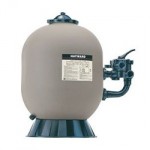Filtration Guide
There are 3 main types of swimming pool filters: Sand, DE (which stands for Diatomaceous Earth), and Cartridge.
Many filters installed in the 70’s and 80’s were much too small for the size of pool they filter, and with the deterioration of age are just barely operating. Newer filters that have not had regular service will not perform any better than an outdated or undersized filter, and can even cause bigger problems. Regular maintenance is the most important factor in continued performance and reliability.
|
|
| Sand Filters |
|
 The sand in a sand filter is specially graded to trap dirt particles. As a sand filter collects dirt, its efficiency increases, trapping even more dirt. When your pressure gauge shows a reading 8-10 lbs. over its clean, start-up reading, it is time to backwash (forcing water to flow through the filter backwards) the captured dirt out of the filter.
If your filter requires frequent backwashing (it should be able to operate continuously for a period of 4 weeks between backwashing), the sand may have deteriorated. A properly sized sand filter can go up to 10 years between sand changes. High amounts of oils from swimmers can gum up a sand bed over time. Years of a pump forcing water over the grains wear away the sharp edges of the sand (think about the Grand Canyon). Worn sand becomes circular, and traps dirt less efficiently. |
|
| Diatomaceous Earth Filters |
|
|
|
The DE filter is the most efficient type of pool filter. It can trap particles smaller than what the naked eye can see. As with sand filters, the pressure gauge indicates a need for backwashing when it reads 8-10 lbs. higher than its “clean” reading. After backwashing a DE filter, a new application of DE filter powder is added to the filter by pouring directly into the skimmer. A semi-annual breakdown of the filter is necessary to thoroughly clean DE filter grids.
|
|
|
A DE filter requires a coating of DE powder on the filter grids. This is where the dirt gets trapped in your filter. The powder, when first added, dissolves in the pipe on its way to the filter tank. When it reaches the grids, the powder stops, coating the grid. The water passes on through the powder, then the fabric covered grid, leaving the dirt trapped in the DE powder coating.
Improperly serviced DE filters may have pressure rise very quickly, and if left without proper DE coating, the grids will become damaged. A properly sized and serviced DE Filter should be able to operate continuously for a period of 4 weeks between backwashing.
|
|
| Cartridge Filters |
|
|
|
A clean cartridge filter element traps dirt and particles of 25-100 microns in size. During routine maintenance, the cartridge must be removed from the tank and washed thoroughly, top to bottom. Each time the filter is cleaned, some of its filtering ability is reduced. The cartridge should be replaced every 2-5 years, depending on the work it was asked to do. If the filter is undersized, and the pool has had some algae and/or tree debris every year (a common problem here in the desert), then it may last only 1-2 years. Correctly sized cartridge filters can operate for 6 months between cleanings.
|
|
|
Share Your Thoughts!